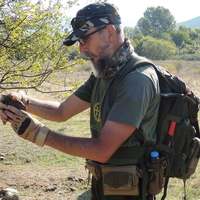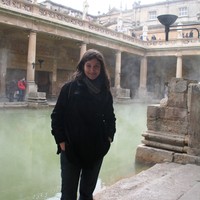Conference Presentations by Vane P. Sekulov

Thermalism in the Roman Provinces The Role of Medicinal Mineral Waters across the Empire, 2024
Abstract: Banja Bansko is located at the foot of the dominant Belasica Mountain, 12 km southeast ... more Abstract: Banja Bansko is located at the foot of the dominant Belasica Mountain, 12 km southeast of the town of Strumica in
southeastern Macedonia. Coins previously discovered at the Parilo spring, which identified it as a sacred spring, were quite
logically contextualised with objects from the cave sanctuary, including the Grotto, the Temple of Hermes and the Great Bath.
The most important part of Banja Bansko is the Parilo spring, located 60 metres southwest of the complex which was supplied
with its thermo-mineral water. The sacred Parilo spring was revered and people were aware of its divine power. Offerings were
deposited at the spring long before the 4th century BC, the period from which the first coins discovered at the spring date, in
order to obtain the favour and blessing of the gods.
The cult continued in the cave formed from the water of the thermo-mineral spring and where a sanctuary was built where the
nymphs were probably worshipped. The sanctuary has two distinct sections that together occupy a total of 135m2: a cave on the
southwestern side and a walled area on the northeastern side.
The Banja Bansko enclosure also includes a temple dedicated to Hermes on the western side. Marble statues or fragments of
marble statues, marble pedestals and small bronze figurines dedicated to Hermes were discovered among the ruins of the
temple. The Great Bath has 11 rooms with 2 large and 2 smaller pools, with a total usable area of 623 m². The bath was built in 3
phases, starting in the 3rd century AD and existed until the mid-5th century AD.
Keywords: Banja Bansko, sacred spring, grotto, Temple of Hermes, The Great Bath
VII International Archaeological Symposium “JEWELRY, from protection to status”, 2023
National Institution Institute for protection of cultural monuments and Museum - Strumica cordially... more National Institution Institute for protection of cultural monuments and Museum - Strumica cordially invite you to participate on the VII International Archaeological Symposium
“JEWELRY, from protection to status”
which will be held from 2 to 5 of November 2023 in Strumica, R.N. Macedonia.
The idea of the symposium is to start a debate about how jewelry, developing over time, becomes first a protector and then a representative of the wearer, simultaneously showing the power, his social and societal status. The jewelry becomes a signaler of the environment, how it should treat the wearer, setting him apart from the general mass of people.
ACTA MUSEI TIBERIOPOLITANI vol.4, 2022
During the archaeological excavations in the site of Crveno Pole located on Ograzden Mountain, in... more During the archaeological excavations in the site of Crveno Pole located on Ograzden Mountain, in the utmost southeast corner of the Republic of North Macedonia near the North Macedonian-Bulgarian border, a very signifi cant type of sword was discovered, among other specimens. The sword was found in the grave n. 72, which is dated in the 2nd-3rd c. A.D. The sword belongs to the ring-pommel typology with a cross-guard. The paper deals with the typological analysis of the sword, which lead us also to export some vital conclusions about the origin of the sword. The special constructive structure of the hilt leads us to connect the ring-pommeled sword with the roman manufacture tradition.

ACTA MUSEI TIBERIOPOLITANI vol.4, 2022
Residents of Crveno Pole (Red Field) buried their deceased in two necropolises, one hundred meter... more Residents of Crveno Pole (Red Field) buried their deceased in two necropolises, one hundred meters away from each other. They started burials at the necropolis at Gushterova Chukarka (The lizard hill) at the end of the 1st century CE which is attested by a coin of Domitian. All of them have stone wreaths around the rectangular pit as a marking of their eternal home up to 4 m in diameter. Almost all wreaths have round form, very rarely it is ellipse. They believed that the soul of the deceased continues to live at the place where he was buried and that is why his eternal home was supplied with everything that he will need for life after life. For women and children they most frequently added ceramic vessels, less frequently jewelry, mostly pair of golden earrings. In case of male deceased, they attached personal arms – regularly two spears with military knife and axe. Some of the deceased bore their swords with them. Most numerous among them are knives and spears. Spears go in a pair almost always, except in one case and always with another type of weapon. They are always accompanied by battle knives and axes and in few cases with swords. Weapons are characterized by the fact that they had been incapacitated before being placed in the graves. The weapon was either bent or, when this action was impossible, its top part was simply cut off .

ACTA MUSEI TIBERIOPOLITANI, 2020
In the last ten years, with systematic archaeological research of the thermo mineral bath in the ... more In the last ten years, with systematic archaeological research of the thermo mineral bath in the village of Bansko, several sculptures and several pedestals were discovered, which are almost certain that they are dedicated to the god Hermes. On one of the sculptures at the level of the left shoulder a part of the kerenicone is preserved. On one marble pedestals there is an inscription on which the enlightener is mentioned, in the name and surname, giving a sculpture in honor of the patron of the temple of Hermes. All sculptures and pedestals were found in a small space, close to one another, some of them in secondary use. The presentation will address the question of whether the remains of the foundations among which these divine remains have been found are based on the ruined temple of Hermes. And more importantly, why was Hermes, who was called god for other human dilemmas, revered in the thermomineral bath in the village of Bansko?

ACTA MUSEI TIBERIOPOLITANI, 2020
In the month of July 2018 with the salvation archaeological excavations at the site Pilav Tepe, a... more In the month of July 2018 with the salvation archaeological excavations at the site Pilav Tepe, a horse skeleton was found in the eastern dwell. The horse was laid on its left side, with twisted neck and his head lying on the lower jaw. The upper part of his skull was missing. The position of the skeleton had been northeast – southwest oriented facing the east side, with dimension of about 1.60m length, 0.60m the height of the chest and 1.10m of the legs (the external parts of the horse hoofs). The horse’s legs, more precisely the position of the metacarpal bones and the hoofs, including the two front and rear shafts were placed in a position parallel to each other. There was a bronze torque wrapped around the jaw, while the horse’s bridle was found southernly right of it. In the text that follows, among the other things, I will try to provide the answers of the following questions: 1. Was this a sacrificial ritual or just an ordinary burial? 2. If it was a burial, was only the horse buried, or altogether with its horseman? 3. Was the horseman of local origin or was a foreign? 4. In which context or historical event have been the horse and the horseman buried?
П Р О Г Р А М А P R O G R A M M E, 2019
THE 5th INTERNATIONAL SYMPOSIUM OF ARCHAEOLOGY CULT, MYTH, RELIGION. Strumica, Macedonia, 2018

The research has been situated in the region of Eastern Macedonia, on the mountains: Ograzden, Pl... more The research has been situated in the region of Eastern Macedonia, on the mountains: Ograzden, Plachkovitsa and Osogovo. The mayor characteristic of these several recently discovered necropolises is that they appear on high altitude, ranging 800 m, up to 1.400 m above sea level. The period in which they are present is taking almost three centuries, from the end of the 1 AD till the end of the 3 AD. The graves are only with cremated deceased, and the cremations were done on the exact place of the burial. The grave pits were framed with wreath of stones, mostly with circular form, but they also appear in ellipsoid or rectangular form. Above them were raised small mounts with diameter of 0,80 m to 10 m, with height of 1 m. The burial inventory is very rich. Mostly there are ceramic vessels done on a pottery wheel, characteristic for the entire Balkan region and wider from the period of the roman domination. We are giving special attention on the pottery done on hand, which is conservative feature of the older traditions of the population from the territory of Macedonia. The presence of the weapons is surprisingly big, especially on the necropolises settled on Ograzden and Plachkovitsa, as well as the ritual of its melting before it was put as a burial offering. Until only six years ago the mountain regions of eastern Macedonia were almost completely unexcavated. There were no or only scarce data for the life in these regions during the ancient period. All known information was based on incomplete research. With the first archaeological excavations in 2001 which were taken in the proximity of the city of Delchevo i.e. on the Osogovo mountain, there were discovered for the first time considerable archaeological remains of settlements and necropolises from the Roman Imperial Period with types of graves as mentioned in the title of this presentation. The scientific interest was intensified on the Plackovica mountain and particularly in 2003 with the systematic excavations on the Ograzden mountain near Novo Selo at the utmost southeast of Macedonia, which resulted in extraordinarily interesting and significant scientific discoveries that enriched and to a great extent changed our knowledge about life during the Roman rule in Eastern Macedonia (Fig.1). With our excavations we have for the first time discovered on the territory of R. Macedonia round stone wreaths from the Roman Imperial Period framing one grave only, which is not necessarily a part of a small mound or together with other graves it is framed into a mound large in size but small in height. The first two necropolises were discovered in the proximity of the villages of Dramche and Bigla. Both of them are at 800m above sea level, on the northeast slopes of the Osogovo mountains. At the site of Chiflik near Dramche, at 10 km northeast of Delchevo we discovered a necropolis comprised of small round tumuli 0.5m high, with a diameter ranging from 4 to 10 meters. This was the first discovery of this type of graves in the Republic of Macedonia. A part of this necropolis was destroyed more than 20 years ago when a road was built. In 2001 and 2002 the remaining of all 21 graves were explored. A mutual characteristics of these tumuli is that they were formed of amorphous river stones heaped on the grave, while the round wreath of each of the graves was formed of large stones. The rite of cremation was employed in all of them. In the middle part of each tumulus there was a shallow hole for the pyre onto which the deceased were burnt together with their clothes, jewelry and other belongings. After the cremation the burnt remains were supplemented with a large number of ceramic vessels, sometimes with glass ones, then coins and weapons (spears and knives) if the deceased was a male (Fig.3), and after that the grave was heaped with stones. Under these tumuli there is, in the most cases, only one burial, but there are several cases where the same grave was used again. The most specific was tumulus No19 (Fig.2), under which 9 graves were found, each 121 electronic version at http://arheologie.ulbsibiu.ro/

The challenge for the NI Institute for Protection of Monuments of Culture and Museum, Strumica to... more The challenge for the NI Institute for Protection of Monuments of Culture and Museum, Strumica to publish this edition Acta Musei Teberipolitani comes as a logical consequence of the already published edition "Water, Llife and Pleasure." This edition summarizes several scienti c papers presented in the second international symposium "The Dead Teach the Living" (Mortui Vivos Docent) held during 2011 and the third international symposium "Usefulness, Strength, Beauty," (Vtilitas, Firmitas, Venustas) ie, "From Wattle and Daub to Mortar" held during 2013. In these symposia were presented several scienti c papers in which arguments dealt with certain issues related to the archeology of the Balkans and the wider area. The latest results of interdisciplinary studies at several localities and areas pertaining to the Balkan Peninsula and beyond are published in sixteen scienti c papers. These papers are intended to familiarize the general public and the experts with the latest information derived from the decades of archaeological research of the region. Some of them refer to funeral practices and others are connected with the architectural activities from prehistoric times until the Middle Ages. Thus, this edition represents another signi cant contribution to the enrichment of knowledge about the activities of cultures and civilizations that left traces in the past of the region.
Papers by Vane P. Sekulov

The research has been situated in the region of Eastern Macedonia, on the mountains: Ograzden, Pl... more The research has been situated in the region of Eastern Macedonia, on the mountains: Ograzden, Plachkovitsa and Osogovo. The mayor characteristic of these several recently discovered necropolises is that they appear on high altitude, ranging 800 m, up to 1.400 m above sea level. The period in which they are present is taking almost three centuries, from the end of the 1 AD till the end of the 3 AD. The graves are only with cremated deceased, and the cremations were done on the exact place of the burial. The grave pits were framed with wreath of stones, mostly with circular form, but they also appear in ellipsoid or rectangular form. Above them were raised small mounts with diameter of 0,80 m to 10 m, with height of 1 m. The burial inventory is very rich. Mostly there are ceramic vessels done on a pottery wheel, characteristic for the entire Balkan region and wider from the period of the roman domination. We are giving special attention on the pottery done on hand, which is conservative feature of the older traditions of the population from the territory of Macedonia. The presence of the weapons is surprisingly big, especially on the necropolises settled on Ograzden and Plachkovitsa, as well as the ritual of its melting before it was put as a burial offering. Until only six years ago the mountain regions of eastern Macedonia were almost completely unexcavated. There were no or only scarce data for the life in these regions during the ancient period. All known information was based on incomplete research. With the first archaeological excavations in 2001 which were taken in the proximity of the city of Delchevo i.e. on the Osogovo mountain, there were discovered for the first time considerable archaeological remains of settlements and necropolises from the Roman Imperial Period with types of graves as mentioned in the title of this presentation. The scientific interest was intensified on the Plackovica mountain and particularly in 2003 with the systematic excavations on the Ograzden mountain near Novo Selo at the utmost southeast of Macedonia, which resulted in extraordinarily interesting and significant scientific discoveries that enriched and to a great extent changed our knowledge about life during the Roman rule in Eastern Macedonia (Fig.1). With our excavations we have for the first time discovered on the territory of R. Macedonia round stone wreaths from the Roman Imperial Period framing one grave only, which is not necessarily a part of a small mound or together with other graves it is framed into a mound large in size but small in height. The first two necropolises were discovered in the proximity of the villages of Dramche and Bigla. Both of them are at 800m above sea level, on the northeast slopes of the Osogovo mountains. At the site of Chiflik near Dramche, at 10 km northeast of Delchevo we discovered a necropolis comprised of small round tumuli 0.5m high, with a diameter ranging from 4 to 10 meters. This was the first discovery of this type of graves in the Republic of Macedonia. A part of this necropolis was destroyed more than 20 years ago when a road was built. In 2001 and 2002 the remaining of all 21 graves were explored. A mutual characteristics of these tumuli is that they were formed of amorphous river stones heaped on the grave, while the round wreath of each of the graves was formed of large stones. The rite of cremation was employed in all of them. In the middle part of each tumulus there was a shallow hole for the pyre onto which the deceased were burnt together with their clothes, jewelry and other belongings. After the cremation the burnt remains were supplemented with a large number of ceramic vessels, sometimes with glass ones, then coins and weapons (spears and knives) if the deceased was a male (Fig.3), and after that the grave was heaped with stones. Under these tumuli there is, in the most cases, only one burial, but there are several cases where the same grave was used again. The most specific was tumulus No19 (Fig.2), under which 9 graves were found, each
… Journal. Proceedings of the 8th International …, 2007
... ArchHung = Archaeologia Hungarica, Budapesta ActaMN = Acta Musei Napocensis, Cluj-NapocaAnale... more ... ArchHung = Archaeologia Hungarica, Budapesta ActaMN = Acta Musei Napocensis, Cluj-NapocaAnalecta Archaeologica Ressoviensia = Analecta Archaeologica Ressoviensia, Institut Archeologii Uniwersytetu Rzeszowskiego Analele Banatului = Analele Banatului, Muzeul ...
… Journal. Proceedings of the 8th International …, 2007
... ArchHung = Archaeologia Hungarica, Budapesta ActaMN = Acta Musei Napocensis, Cluj-NapocaAnale... more ... ArchHung = Archaeologia Hungarica, Budapesta ActaMN = Acta Musei Napocensis, Cluj-NapocaAnalecta Archaeologica Ressoviensia = Analecta Archaeologica Ressoviensia, Institut Archeologii Uniwersytetu Rzeszowskiego Analele Banatului = Analele Banatului, Muzeul ...
Books by Vane P. Sekulov

INTERNATIONAL SCIENTIFIC CONFERENCE 75 YEAR JUBILEE OF THE INSTITUTE OF ART HISTORY AND ARCHAEOLOGY 12th – 14th October 2022 Dojran, Macedonia
Abstract: Construction workers discover a tomb in the historic district of Strumica. The
Nationa... more Abstract: Construction workers discover a tomb in the historic district of Strumica. The
National Institute for the Protection of Cultural Monuments and Museum - Strumica will be
ready as quickly as feasible for the inspection of the tomb and the entire area of the construction
plot, and the construction work will stop.
The tomb is divided into two sections: a segment that is accessible through a stairway and
the dromos burial chamber and hypogeum. Its outside dimensions are 3.15 m long and 1.65 m
broad. Northwest through southeast is the orientation.
A grave was also discovered while conducting study in the local area of the tomb. It is a
burial form with double-pitch roof, i.e. “alla cappuccino” type, arranged horizontally along the
longer length, with one tegula from each of the northeast and southwest sides
More terracotta figurine and pottery vessel fragments were discovered nearby after the
initial examination and later during the excavation of the tomb and its surroundings. Of course,
the discovery of the statuette depicting a rooster is the most intriguing.










Uploads
Conference Presentations by Vane P. Sekulov
southeastern Macedonia. Coins previously discovered at the Parilo spring, which identified it as a sacred spring, were quite
logically contextualised with objects from the cave sanctuary, including the Grotto, the Temple of Hermes and the Great Bath.
The most important part of Banja Bansko is the Parilo spring, located 60 metres southwest of the complex which was supplied
with its thermo-mineral water. The sacred Parilo spring was revered and people were aware of its divine power. Offerings were
deposited at the spring long before the 4th century BC, the period from which the first coins discovered at the spring date, in
order to obtain the favour and blessing of the gods.
The cult continued in the cave formed from the water of the thermo-mineral spring and where a sanctuary was built where the
nymphs were probably worshipped. The sanctuary has two distinct sections that together occupy a total of 135m2: a cave on the
southwestern side and a walled area on the northeastern side.
The Banja Bansko enclosure also includes a temple dedicated to Hermes on the western side. Marble statues or fragments of
marble statues, marble pedestals and small bronze figurines dedicated to Hermes were discovered among the ruins of the
temple. The Great Bath has 11 rooms with 2 large and 2 smaller pools, with a total usable area of 623 m². The bath was built in 3
phases, starting in the 3rd century AD and existed until the mid-5th century AD.
Keywords: Banja Bansko, sacred spring, grotto, Temple of Hermes, The Great Bath
“JEWELRY, from protection to status”
which will be held from 2 to 5 of November 2023 in Strumica, R.N. Macedonia.
The idea of the symposium is to start a debate about how jewelry, developing over time, becomes first a protector and then a representative of the wearer, simultaneously showing the power, his social and societal status. The jewelry becomes a signaler of the environment, how it should treat the wearer, setting him apart from the general mass of people.
Papers by Vane P. Sekulov
Books by Vane P. Sekulov
National Institute for the Protection of Cultural Monuments and Museum - Strumica will be
ready as quickly as feasible for the inspection of the tomb and the entire area of the construction
plot, and the construction work will stop.
The tomb is divided into two sections: a segment that is accessible through a stairway and
the dromos burial chamber and hypogeum. Its outside dimensions are 3.15 m long and 1.65 m
broad. Northwest through southeast is the orientation.
A grave was also discovered while conducting study in the local area of the tomb. It is a
burial form with double-pitch roof, i.e. “alla cappuccino” type, arranged horizontally along the
longer length, with one tegula from each of the northeast and southwest sides
More terracotta figurine and pottery vessel fragments were discovered nearby after the
initial examination and later during the excavation of the tomb and its surroundings. Of course,
the discovery of the statuette depicting a rooster is the most intriguing.
southeastern Macedonia. Coins previously discovered at the Parilo spring, which identified it as a sacred spring, were quite
logically contextualised with objects from the cave sanctuary, including the Grotto, the Temple of Hermes and the Great Bath.
The most important part of Banja Bansko is the Parilo spring, located 60 metres southwest of the complex which was supplied
with its thermo-mineral water. The sacred Parilo spring was revered and people were aware of its divine power. Offerings were
deposited at the spring long before the 4th century BC, the period from which the first coins discovered at the spring date, in
order to obtain the favour and blessing of the gods.
The cult continued in the cave formed from the water of the thermo-mineral spring and where a sanctuary was built where the
nymphs were probably worshipped. The sanctuary has two distinct sections that together occupy a total of 135m2: a cave on the
southwestern side and a walled area on the northeastern side.
The Banja Bansko enclosure also includes a temple dedicated to Hermes on the western side. Marble statues or fragments of
marble statues, marble pedestals and small bronze figurines dedicated to Hermes were discovered among the ruins of the
temple. The Great Bath has 11 rooms with 2 large and 2 smaller pools, with a total usable area of 623 m². The bath was built in 3
phases, starting in the 3rd century AD and existed until the mid-5th century AD.
Keywords: Banja Bansko, sacred spring, grotto, Temple of Hermes, The Great Bath
“JEWELRY, from protection to status”
which will be held from 2 to 5 of November 2023 in Strumica, R.N. Macedonia.
The idea of the symposium is to start a debate about how jewelry, developing over time, becomes first a protector and then a representative of the wearer, simultaneously showing the power, his social and societal status. The jewelry becomes a signaler of the environment, how it should treat the wearer, setting him apart from the general mass of people.
National Institute for the Protection of Cultural Monuments and Museum - Strumica will be
ready as quickly as feasible for the inspection of the tomb and the entire area of the construction
plot, and the construction work will stop.
The tomb is divided into two sections: a segment that is accessible through a stairway and
the dromos burial chamber and hypogeum. Its outside dimensions are 3.15 m long and 1.65 m
broad. Northwest through southeast is the orientation.
A grave was also discovered while conducting study in the local area of the tomb. It is a
burial form with double-pitch roof, i.e. “alla cappuccino” type, arranged horizontally along the
longer length, with one tegula from each of the northeast and southwest sides
More terracotta figurine and pottery vessel fragments were discovered nearby after the
initial examination and later during the excavation of the tomb and its surroundings. Of course,
the discovery of the statuette depicting a rooster is the most intriguing.